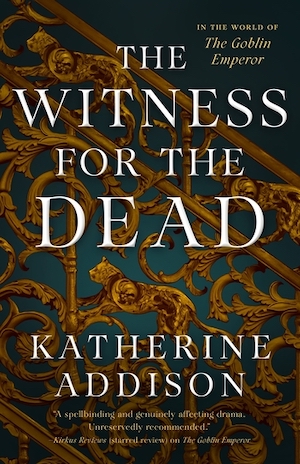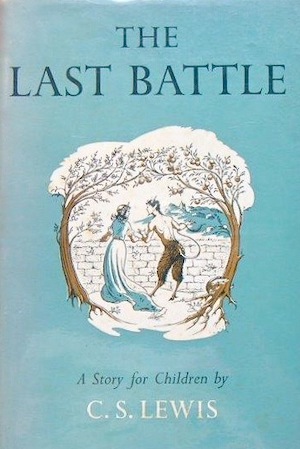We’ve been doing the C.S. Lewis Reread here at Tor.com for over a year, and I’ve felt mounting dread about re-reading The Last Battle. As a kid it was my favorite of the Narnia books, and one that—even though I read it when I was eight—has shaped some significant theological thought in my life that still has an impact on me today. On the other hand, there’s the “problem of Susan” (and don’t worry, we’ll definitely be looking at this aspect of the book in detail). There’s the reality that the Calormenes play a significant role in this book, which means we’re going to see the worst of Lewis’ ethnocentrism (and, let’s be frank…racism) on display.
So, for me, it’s the most troubling of the Narnia books but also one that has been the most transformative for me personally. So I picked it up last week with a decent amount of trepidation. I was afraid that the wonderful things I remembered would be worse than I remembered, and that the troubling things would be worse than I remembered, too.
I’m glad to report my fears were only half realized. The wonderful things, like Jewel the unicorn, the terror of Tash, the cameos from the rest of the series, the conversation between Aslan and Emeth, all still felt fresh, wonderful, vibrant, and enjoyable. I choked up more than once at some of the profoundly affecting scenes of reunion or gut-wrenching farewells. And the noble friendship between the king of Narnia and Jewel the unicorn was more poignant and beautiful in the courtly tradition of Malory than I remembered. On the other hand, the racism element was far more stark when encountered as an adult than it had seemed when I was a child, including a frustrating back-and-forth in my head about what exactly Lewis is trying to say with the talking ape, Shift. Was he making a well-worn racist allusion to Black people, or is it just that sometimes when you live in Narnia the bad guys are talking animals and sometimes talking animals happen to be apes? I kept saying to myself surely it’s the latter, but there’s one line in particular that makes it hard not to suspect the former.
The Last Battle is about endings, and what comes after the end. It’s about how to face death with courage. It’s about love, and abuse, and how communal belief works. It’s about transformation; it’s about the true nature of Aslan; it’s about chivalry and royalty and war and propaganda and cruelty and heroism. There’s a lot in this book.
On the theological side, much of the book deals with Lewis’s soteriology (the study of how “salvation” works) and Lewis’s thoughts about the afterlife (especially Heaven). We’ll get a much more detailed look at some of this when we get to The Great Divorce, but I think the vision presented in The Last Battle may be more compelling. We also get some clues to how Lewis’s rather unique idea of spiritual transformation works in the afterlife…whether one is moving toward deity or toward beastliness. And, for the first time really in Narnia, we see an example of spiritual stagnation.
Things to be watching for as you read:
- Lewis offers a chilling depiction of manipulation, abuse, and spiritual abuse. We’ll be exploring this in the next article. Keep an eye on this, and the punishment that Lewis creates for the creatures who perpetrate it.
- The nature of communal belief. Look at how the beliefs about Aslan alter, transform, and are perverted throughout the narrative. And pay special attention to when and where Aslan shows up (as always).
- The friendship of King Tirian and Jewel really is lovely and hearkens back to some of Lewis’s favorite knightly stories.
- There are unicorns in Narnia now apparently! Neat.
- Cameos galore! Almost everyone gets a few sentences to drop in and say hello, with one tremendously disappointing exception that has infuriated readers for decades.
- On that note, look carefully at the passage about Susan, and what it actually says rather than how it makes us feel. We’re going to explore both of those things, and Lewis absolutely failed here, but we know for a fact that he was rather surprised by the response people had to his choices regarding Queen Susan of Narnia—one of the four royal personages of Cair Paravel! Show some respect, Mr. Lewis!
- The references to Plato grow from quiet nods to shouted, repeated blinking signs and Professor Kirke saying aloud that it’s “all in Plato.” So I guess we should be paying attention to that.
- The moral world of Lewis is on display here. What does it mean to be a good person? Are we complicit when we are deceived? Is ignorance a sign of evil? Why do people (or, you know, talking animals) enter into belief systems that literally enslave them? Can we recognize those who use religion to ensnare, control, and use others?
- Lewis, for the first time, pushes against his own metaphorical usages related to Narnia. Take a close look at Eustace and Jill’s conversation about what might happen to them if they were to die in Narnia. There’s an implicit critique of the boundaries of the usefulness of the Narnia metaphor.
- Be watching for Lewis’s insistence that hope exists in the world, and with good reason.
A few more thoughts for this brief intro. It’s good to remember that Lewis started writing this book in 1952, and finished writing it in 1953. He wouldn’t finish writing The Magician’s Nephew until the following year, and that book as well as The Horse and His Boy were yet to be published.
Buy the Book


The Witness for the Dead
The Last Battle was finally published in 1956—three years after he completed it—and the same year that Till We Have Faces (final work of fiction) was published; Lewis’s short story “The Shoddy Lands” was published in The Magazine of Fantasy and Science Fiction in 1956 as well. He had married Joy Gresham the year before. The Last Battle is the only book in the Chronicles of Narnia to win an award at the time it was published. It won the Carnegie Medal in 1956.
I’ll close with this: The Last Battle is, in many ways, the most challenging of the Narnia books. Not only because of the many things mentioned above, but because Lewis’s picture of death and how to respond to death is so outside the norm as to seem alien….
Lewis himself was aware of this. Here’s a paragraph from a letter he wrote to a friend discussing this topic straight out:
What a state have we got into when we can’t say ‘I’ll be happy when God calls me’ without being afraid one will be thought ‘morbid’. After all, St. Paul said just the same. If we really believe what we say we believe—if we really think that home is elsewhere and this life is a ‘wandering to find home’, why should we not look forward to the arrival. There are, aren’t there, only three things we can do about death: to desire it, to fear it, or to ignore it. The third alternative, which is the one the modern world calls ‘healthy’ is surely the most uneasy and precarious of all.
Lewis thought it not only perfectly natural, but even desirable that a Christian person would eagerly look forward to death. We’ve seen that expressed before in Reepicheep, and now we’re seeing the culmination of that idea in this book: everyone should embrace death with some measure of joy, from Lewis’s point of view.
In fact, when this same friend of his wrote as her health started to fail, Lewis repeated the idea, saying, “What is there to be afraid of? You have long attempted (and none of us does more) a Christian life. Your sins are confessed and absolved. Has this world been so kind to you that you should leave it with regret? There are better things ahead than any we leave behind.”
I’ve said from the very beginning of this series that part of what I hope to accomplish is to be a sort of translator and guide for those who may not share Lewis’s faith (and mine). One of the many critiques I’ve seen of this book is that with all the emphasis on joy and happiness in the face of death, there’s precious little space left for grief and sorrow, and I think that’s fair. Lewis was a man who knew grief and sorrow, and in fact they seemed to hang over his whole life in some ways. He lost his mother as a child, a close friend in the war, and married a woman who he had come to love deeply who was already terminally ill. It’s just that Lewis believed—honestly believed, somewhere deeper than his own grief—that in the presence of Aslan all would be set right, every sorrow counterbalanced with joy, every grief resolved in reunion.
So, as we step into these deep waters to reflect on Lewis’s thoughts about the end of the world, the end of Narnia, the end (and beginning) of everything, let’s do our best to be gentle to one another along the way. The world is full of enough pain and trouble without us adding to it, and this book has a special way of hitting readers in vulnerable places (in ways both good and bad, depending on the reader and the issue).
And, like King Tirian and Jewel the unicorn, we can, at least, face it all together.
 Matt Mikalatos is the author of the YA fantasy The Crescent Stone. You can follow him on Twitter or connect on Facebook.
Matt Mikalatos is the author of the YA fantasy The Crescent Stone. You can follow him on Twitter or connect on Facebook.










